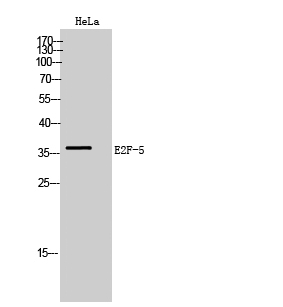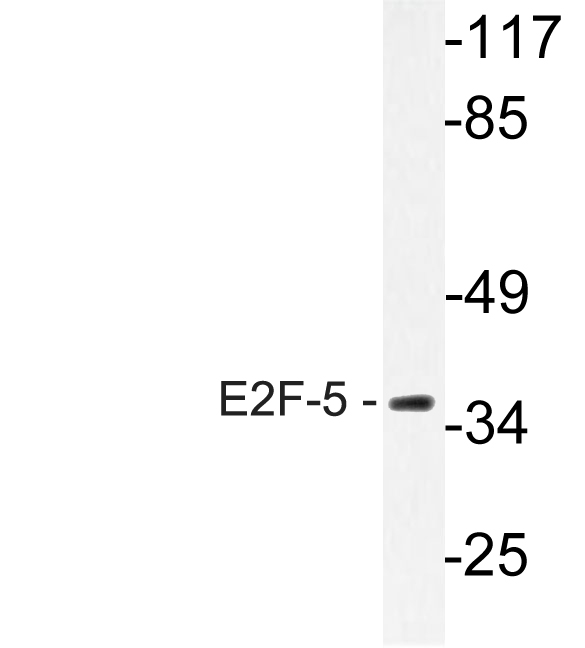E2F-5 Polyclonal Antibody
- Catalog No.:YT1445
- Applications:WB;ELISA
- Reactivity:Human;Mouse;Rat
- Target:
- E2F-5
- Fields:
- >>Cell cycle;>>Cellular senescence;>>TGF-beta signaling pathway
- Gene Name:
- E2F5
- Protein Name:
- Transcription factor E2F5
- Human Gene Id:
- 1875
- Human Swiss Prot No:
- Q15329
- Mouse Gene Id:
- 13559
- Mouse Swiss Prot No:
- Q61502
- Rat Swiss Prot No:
- Q62814
- Immunogen:
- The antiserum was produced against synthesized peptide derived from human E2F-5. AA range:93-142
- Specificity:
- E2F-5 Polyclonal Antibody detects endogenous levels of E2F-5 protein.
- Formulation:
- Liquid in PBS containing 50% glycerol, 0.5% BSA and 0.02% sodium azide.
- Source:
- Polyclonal, Rabbit,IgG
- Dilution:
- WB 1:500 - 1:2000. ELISA: 1:20000. Not yet tested in other applications.
- Purification:
- The antibody was affinity-purified from rabbit antiserum by affinity-chromatography using epitope-specific immunogen.
- Concentration:
- 1 mg/ml
- Storage Stability:
- -15°C to -25°C/1 year(Do not lower than -25°C)
- Other Name:
- E2F5;Transcription factor E2F5;E2F-5
- Observed Band(KD):
- 36kD
- Background:
- The protein encoded by this gene is a member of the E2F family of transcription factors. The E2F family plays a crucial role in the control of cell cycle and action of tumor suppressor proteins and is also a target of the transforming proteins of small DNA tumor viruses. The E2F proteins contain several evolutionarily conserved domains that are present in most members of the family. These domains include a DNA binding domain, a dimerization domain which determines interaction with the differentiation regulated transcription factor proteins (DP), a transactivation domain enriched in acidic amino acids, and a tumor suppressor protein association domain which is embedded within the transactivation domain. This protein is differentially phosphorylated and is expressed in a wide variety of human tissues. It has higher identity to E2F4 than to other family members. Both this protein and E2F4 inter
- Function:
- function:Transcriptional activator that binds to E2F sites, these sites are present in the promoter of many genes whose products are involved in cell proliferation. May mediate growth factor-initiated signal transduction. It is likely involved in the early responses of resting cells to growth factor stimulation.,similarity:Belongs to the E2F/DP family.,subunit:Component of the DRTF1/E2F transcription factor complex. Binds cooperatively with DP-1 to E2F sites. Interaction with retinoblastoma protein RB1 or proteins RBL1 and RBL2 inhibits the E2F transactivation domain. Component of the DREAM complex (also named LINC complex) at least composed of E2F4, E2F5, LIN9, LIN37, LIN52, LIN54, MYBL1, MYBL2, RBL1, RBL2, RBBP4, TFDP1 and TFDP2. The complex exists in quiescent cells where it represses cell cycle-dependent genes. It dissociates in S phase when LIN9, LIN37, LIN52 and LIN54 form a subcom
- Subcellular Location:
- Nucleus.
- Expression:
- Brain,Colon carcinoma,Fetal lung,Placenta,
- June 19-2018
- WESTERN IMMUNOBLOTTING PROTOCOL
- June 19-2018
- IMMUNOHISTOCHEMISTRY-PARAFFIN PROTOCOL
- June 19-2018
- IMMUNOFLUORESCENCE PROTOCOL
- September 08-2020
- FLOW-CYTOMEYRT-PROTOCOL
- May 20-2022
- Cell-Based ELISA│解您多样本WB检测之困扰
- July 13-2018
- CELL-BASED-ELISA-PROTOCOL-FOR-ACETYL-PROTEIN
- July 13-2018
- CELL-BASED-ELISA-PROTOCOL-FOR-PHOSPHO-PROTEIN
- July 13-2018
- Antibody-FAQs
- Products Images

- Western Blot analysis of HeLa cells using E2F-5 Polyclonal Antibody

- Western blot analysis of lysate from HeLa cells, using E2F-5 antibody.



